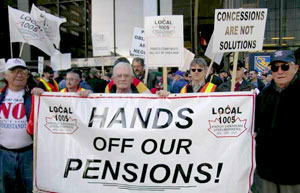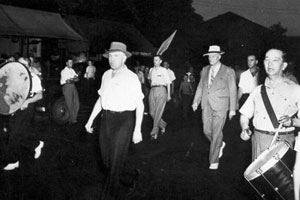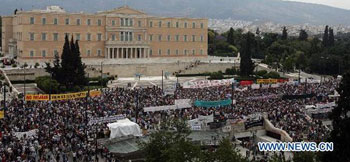International Workers' Movement
• Buffalo Joins in Celebrating 65th Anniversary of Hamilton Steelworkers’ Local 1005 and Spirit of ‘46
• Congratulations USW Local 1005 — 65 Years and Still Fighting!
• Hold Canadian Governments to Account to Defend Stelco Steelworkers and Pensioners
• Britain: Militant Strikes Over Pensions
• Greece: No Means No!
• Greek People Break New Ground
Buffalo Joins in Celebrating 65th Anniversary of Hamilton Steelworkers’ Local 1005 and Spirit of ‘46
 Buffalo Forum sent a delegation to the July 23 day-long community-sponsored picnic in Hamilton, Ontario, Cananda, held to celebrate the 65th anniversary of the founding of United Steelworkers (USW) Local 1005. We extended our congratulations to Local 1005 and all those joining in this important fight defending the rights of all. Buffalo, with its many retired steelworkers who lost their healthcare and most of their pensions, greatly appreciates this effort to stand firm in defending pensions, for retirees and new hires. As we told the Hamilton steelworkers, we are one with them and with the spirit of ’46, which is a spirit of resistance and saying All for One and One for All!
Buffalo Forum sent a delegation to the July 23 day-long community-sponsored picnic in Hamilton, Ontario, Cananda, held to celebrate the 65th anniversary of the founding of United Steelworkers (USW) Local 1005. We extended our congratulations to Local 1005 and all those joining in this important fight defending the rights of all. Buffalo, with its many retired steelworkers who lost their healthcare and most of their pensions, greatly appreciates this effort to stand firm in defending pensions, for retirees and new hires. As we told the Hamilton steelworkers, we are one with them and with the spirit of ’46, which is a spirit of resistance and saying All for One and One for All!
The activities in Gage Park began at 12 noon and carried on until 11 pm. The support of the workers and their battle against U.S. Steel could be seen in the thousands of hamburgers, sausages, sodas, and cookies dontated by local businesses, along with tents, chairs, refrigerated trucks and more. Numerous bands donated their talents and provided entertainment through out the day. Every sector of the city came forward to provide support. The local Workers’ Arts and Heritage Center (WAHC) also provided its enthusiastic support for the anniversary celebration. WAHC presented an exhibit at the picnic under the theme “The Spirit of ‘46.”
Active and retired steelworkers of United Steelworkers Local 1005, along with the broader community joined in making the event a success. This important occasion marked the 65th anniversary of the historic 1946 strike, when workers fought a long and hard struggle to force the government to recognize their union, USW 1005.
The event was not only a milestone for the labor movement but also a truly community affair, with a prominent role played by the youth who volunteered their time and efforts for everything from infrastructure set-up to food service to gathering toonies ($2) for the Toonies for Billboards campaign in support of Local 1005. Several billboards can already be seen in Hamilton and more are planned. The community also organized car-pooling down to Gage Park while youth and other community members widely promoted the event. They reported that while distributing leaflets and posters for the occasion across the city, they received a warm response. Many families have relatives who have worked at Stelco and who greatly appreciate the determined stand of Local 1005 to defend penisons and reject the extortion of U.S. Steel.
The picnic was a converging point for all those from Hamilton and beyond standing as one against the dictate of U.S. Steel. In 1946, the workers and their communities were able to make headway because the union fought and a critical mass of workers stood with it in the face of great difficulties. Today, as in 1946, the city of Hamilton and the labor movement across Canada stand with the steelworkers. Hamiltonians were happy to hear that Buffalo and workers across the U.S. stand with them against U.S. Steel!
Below we reprint two articles from TML daily (cpcml.ca) about the Local 1005 struugle to defend the rights of all.
[TOP]
Congratulations USW Local 1005 — 65 Years and Still Fighting!
TML congratulates the leadership of USW Local 1005 and all members and retirees for the strong defense of their rights and the rights of all.
On the occasion of the celebration of the 65th anniversary of USW Local 1005, Anna Di Carlo, leader of the Marxist-Leninist Party of Canada sent Local 1005 a message of congratulations in which she addressed the significance of having a union which defends the rights of all, especially in the context of today’s anti-worker, anti-social, anti-national offensive where everyone is expected to fend for themselves.
The anniversary celebrates the historic strike in 1946 when the steelworkers stood their ground until the company was forced to recognize the union as the workers’ bargaining agent. No matter how much the company tried to persuade workers that life would be sweeter without a union, this did not succeed. It is thanks to the collective of workers at Stelco, organized into Local 1005, that the standard of living for other collectives and the community was raised. The community would have been deprived of one of its greatest asset if Local 1005 had not stood its ground at that time.
Stelco Strike of 1946
 Throughout its history Local 1005 has faced constant attacks from directors and executive managers who wanted to smash it and impose their will on the workers with impunity. Today the attacks are all the more brutal because governments are no longer interested in looking after the health and well-being of citizens and residents and maintaining their standard of living. They are paying the rich, which means the rich get richer at the expense of the majority, which gets poorer. Furthermore, keeping labor healthy is not a priority when nation wrecking is destroying manufacturing and it is cheaper to import cheap labor as foreign guest workers or refugees fleeing desperate situations and so on. As a result, the workers are facing a battle similar to the one in 1946 even though the conditions are different due to the current anti-social and anti-national offensive. In 1946, the workers’ movement had to force the monopolies and governments in their service to recognize the unions as bargaining agents which defend the rights of their members and this must be done all over again, at a time when the unions are being told to sacrifice the rights of their members in the name of making the monopolies competitive on global markets.
Throughout its history Local 1005 has faced constant attacks from directors and executive managers who wanted to smash it and impose their will on the workers with impunity. Today the attacks are all the more brutal because governments are no longer interested in looking after the health and well-being of citizens and residents and maintaining their standard of living. They are paying the rich, which means the rich get richer at the expense of the majority, which gets poorer. Furthermore, keeping labor healthy is not a priority when nation wrecking is destroying manufacturing and it is cheaper to import cheap labor as foreign guest workers or refugees fleeing desperate situations and so on. As a result, the workers are facing a battle similar to the one in 1946 even though the conditions are different due to the current anti-social and anti-national offensive. In 1946, the workers’ movement had to force the monopolies and governments in their service to recognize the unions as bargaining agents which defend the rights of their members and this must be done all over again, at a time when the unions are being told to sacrifice the rights of their members in the name of making the monopolies competitive on global markets.
USW Local 1005 has been locked out by U.S. Steel for more than eight months in a blatant abuse of power to extort the “agreement” of the workers to give in on de-indexing of pensions and giving up a defined benefit pension plan for new hires. Already the directors and executive managers of companies are imposing that on workers all over the country thus dragging down the standard of living of the entire country. U.S. Steel CEO Surma says all the time that in the U.S., workers no longer have indexed and defined-benefit pensions and for him that is the established norm. Surma and his followers say accepting the lower standard is “realistic” and that we should give in to the reality of his company’s power.
 We are sure Surma believes that a lower standard of living for U.S. and Canadian workers and retirees is “realistic” just as his $12.1 million pay check in 2010 for himself was “realistic.” But the workers refuse to accept as “realistic” a $12.1 million annual salary for him, the ending of indexed pensions for themselves, a two-tier workplace and the possible cratering of Stelco Hamilton Works. That kind of realism is self-destructive and suicidal, a kind of mafia enforced realism where extortion works because governments are not upholding a rule of law where extortion against the workers is illegal, their rights are protected and governments uphold public right, not monopoly right.
We are sure Surma believes that a lower standard of living for U.S. and Canadian workers and retirees is “realistic” just as his $12.1 million pay check in 2010 for himself was “realistic.” But the workers refuse to accept as “realistic” a $12.1 million annual salary for him, the ending of indexed pensions for themselves, a two-tier workplace and the possible cratering of Stelco Hamilton Works. That kind of realism is self-destructive and suicidal, a kind of mafia enforced realism where extortion works because governments are not upholding a rule of law where extortion against the workers is illegal, their rights are protected and governments uphold public right, not monopoly right.
Steelworkers and all of Hamilton have protested the idea that destroying their steel mill and standard of living are realistic. That may be realistic for a CEO living in Pittsburgh who thinks he can extort Canadians into reducing their standard of living down to the lowest common denominator in the U.S. but that is not realistic for Canadians. Surma’s logic, for example, would mean that Canada must give up public Medicare and move downwards to the chaos and insecurity of a U.S. private healthcare system.
 Canadians uphold as realistic their social responsibilities to themselves, their future members, retirees and community, and that they should not be abandoned just as workers in the U.S. should not be abandoned either. People from across the country look to the Hamilton steelworkers with pride; they applaud their courageous stand and wish them well. AbitibiBowater retirees from Donnacona near Quebec City, along with autoworker retirees from Oshawa and Windsor, Nortel pensioners and many, many others have joined to express their unity in the fight for Canadian-standard pensions for all. At the January 29 province-wide Hamilton Day of Action organized by the Ontario Federation of Labor, workers declared that the fight was The People vs. U.S. Steel and declared the fight of 1005 against concessions to be the line in the sand.
Canadians uphold as realistic their social responsibilities to themselves, their future members, retirees and community, and that they should not be abandoned just as workers in the U.S. should not be abandoned either. People from across the country look to the Hamilton steelworkers with pride; they applaud their courageous stand and wish them well. AbitibiBowater retirees from Donnacona near Quebec City, along with autoworker retirees from Oshawa and Windsor, Nortel pensioners and many, many others have joined to express their unity in the fight for Canadian-standard pensions for all. At the January 29 province-wide Hamilton Day of Action organized by the Ontario Federation of Labor, workers declared that the fight was The People vs. U.S. Steel and declared the fight of 1005 against concessions to be the line in the sand.
The production of steel is crucial to build Canada into what it can be and refuse to accept the line that there is no alternative to the destruction of productive facilities and a downward spiral of wages, benefits, pensions, and working and living conditions. In this struggle, Canadians expect the federal and provincial governments to stand with them and defend their rights in the face of this abuse from a U.S. company. Canadians will hold their governments to account for not defending them.
In her message of greetings to the members of Local 1005 on the 65th anniversary of their founding, Anna Di Carlo wrote:
“.... Sixty-five years is many lessons learned of which the essential one is that for the individual needs of a worker to be met, they must unite with other workers and as a collective fight for the security of all. Individual security is bound up in the security of all. Individual well-being for workers is bound up in the well-being of all not on an egalitarian basis, but because of the reality of the state power held by the monopolies versus the class position of the workers and the relative powerlessness of individual workers. Congratulations 1005!”
Local 1005 -- 65 and Still Fighting! [TOP]
All for One and One for All!
Hold Canadian Governments to Account to Defend Stelco Steelworkers and Pensioners
 The owners and directors of U.S. Steel are attacking the pensions of Canadian steelworkers. The steelworkers and their defense organization USW Local 1005 are resisting this attack. The owners and directors of U.S. Steel are attempting to dismantle bit by bit a Canadian pension plan that came into being fifty years ago at Stelco and underwent various improvements over the years. The Stelco pension plans met a need that was missing and is still missing from the collective life of Canadians: pensions underwritten by government that guarantee a Canadian standard livelihood in retirement. In the absence of government guaranteed pensions for all, Canadian workers fought for company pension plans that would fill the gap until such time Canadian governments fulfill their social responsibilities to Canada’s retired population.
The owners and directors of U.S. Steel are attacking the pensions of Canadian steelworkers. The steelworkers and their defense organization USW Local 1005 are resisting this attack. The owners and directors of U.S. Steel are attempting to dismantle bit by bit a Canadian pension plan that came into being fifty years ago at Stelco and underwent various improvements over the years. The Stelco pension plans met a need that was missing and is still missing from the collective life of Canadians: pensions underwritten by government that guarantee a Canadian standard livelihood in retirement. In the absence of government guaranteed pensions for all, Canadian workers fought for company pension plans that would fill the gap until such time Canadian governments fulfill their social responsibilities to Canada’s retired population.
People justly demand how the owners and directors of U.S. Steel have the right to dismantle a Canadian company’s pension plans when governments have not yet committed resources to meet the needs of all retired Canadians. The necessity for company plans is still with us, as a public government pension plan for all at Canadian standards is still missing.
The owners and directors of U.S. Steel came to Canada in 2007 and bought Stelco from various asset management companies that had seized the company’s assets during a fraudulent bankruptcy process. Almost none of the money U.S. Steel paid for Stelco went to the company as most of it was taken by the asset management companies and their appointed CEO at the time, Rodney Mott, who absconded with millions back to the U.S.
The owners and directors of U.S. Steel first locked out steelworkers at Stelco’s Lake Erie Works to extort a dismantling of their pension plan and are now attempting the same thing at Stelco’s Hamilton Works, which has more than 9,000 retirees and 900 active steelworkers.
 Company pensions reside on two fundamental issues: the amount of social product available to the company, and the division of that social product amongst the workers, governments and the owners of capital. The problem faced by workers is that they are not on an equal footing with the owners of monopoly capital on decisions dealing with those two fundamental issues. The owners and directors of U.S. Steel are dictating an eventual wrecking of the pension plan. They are also the ones in charge of how much social product is produced and are using their positions and global empire with dozens of mills to dictate how the available social product is distributed to the three main claimants.
Company pensions reside on two fundamental issues: the amount of social product available to the company, and the division of that social product amongst the workers, governments and the owners of capital. The problem faced by workers is that they are not on an equal footing with the owners of monopoly capital on decisions dealing with those two fundamental issues. The owners and directors of U.S. Steel are dictating an eventual wrecking of the pension plan. They are also the ones in charge of how much social product is produced and are using their positions and global empire with dozens of mills to dictate how the available social product is distributed to the three main claimants.
Since buying Stelco, the owners and directors of U.S. Steel have either shut down the two Canadian mills altogether or run them at less than full capacity. This means the social product available to fund the pension plans has been severely depressed under the rule of the owners and directors of U.S. Steel. On the second fundamental issue, the division of the available social product, the owners and directors of U.S. Steel have simply issued decrees to dismantle the Canadian pension plans and change the division of the social product amongst the three main claimants to favor owners of equity and debt in the U.S.
This puts steelworkers in a real bind. They do not hold the decision-making power to increase the total social product available for distribution among the claimants. On this front, the owners and directors of U.S. Steel shut down the blast furnace at Hamilton Works over eight months ago because of what they called poor economic conditions and show no interest in restarting it. Subsequently, they changed the shutdown into a lockout to extort the dismantling of the pension plan. Hamilton Works is not producing steel only some metallurgical coke. Almost no social product is available for distribution. Steelworkers have consistently said they want to keep Stelco producing but the owners and directors of U.S. Steel appear determined to fill the Canadian order book with steel produced in their other mills. This situation can be described as U.S. monopoly right riding roughshod over Canadian public right.
The owners and directors of U.S. Steel suggest that Hamilton Works does not produce enough social product to fund the existing pension plan yet they have done everything to block the mill from producing any steel at all let alone invest in the mill to ensure that it can produce greater amounts of social product. The owners and directors of U.S. Steel have created a situation where Hamilton steelworkers are not producing any social product that can be divided up amongst the three main claimants. The same owners and directors of U.S. Steel then persist in saying that not enough social product is available to fund the existing pension plan. This is U.S. monopoly right running roughshod over Canadian public right. This is unconscionable and Canadians should be outraged and demand that the owners and directors of U.S. Steel be held to account for their reckless self-serving actions and that the federal and Ontario governments should be held to account for refusing to intervene on the side of their fellow Canadians.
The actions of the owners and directors of U.S. Steel since seizing control of Stelco are nothing less than U.S. imperialist thuggery. They suggested without any proof that the former Stelco cannot produce enough social product to fund the existing pension plans and that the division of the social product must be changed so that more goes to the new U.S. owners and directors of Stelco and less to Canadian steelworkers and their governments.
First, the assertion that social product is lacking is unproven and secondly, if that is found to be the case then workers would naturally want to increase the production of social product to meet the needs of the claimants not change the division of the available social product. However, workers are ignored on this front, as those owners and directors who make the assertion of a lack of social product are the same ones that control the amount of production. Instead of organizing to produce more social product, at least enough to meet apparent Canadian demand, these same owners and directors who declared a lack of social product have proceeded to shut down production of Stelco social product at both mills and dictate changes to how the social product is distributed so that more goes into their U.S. coffers and less to steelworkers and Canadian governments.
Canadians must not allow this U.S. imperialist thievery to take place. The same ruling clique has ruined the U.S. economy through impoverishing the U.S. working class and war spending, and has now come to Canada to do the same. Canadians must unite around Local 1005 steelworkers and demand that governments intervene to force the owners and directors of U.S. Steel to back off immediately from this anti-social anti-Canadian course of reducing production at Stelco and dictating changes in how its social product is distributed. The federal and Ontario governments must pass legislation immediately demanding the owners and directors of U.S. Steel begin producing steel at Stelco at the levels agreed to in the 2007 seizure agreement with Investment Canada, reinstate the pension plan at Lake Erie Works as it was, honor the existing pension arrangements and collective agreement at Hamilton Works and pay restitution for all damages they have caused in lost production since 2007. If the owners and directors of U.S. Steel refuse to do so, the governments should take back Stelco based on the 2007 selling price minus all the damages caused by the owners and directors of U.S. Steel and prohibit the company from engaging in any further business in Canada.
Canadian public right must prevail over U.S. monopoly right! [TOP]
Hold our governments to account to protect and serve Canadians who are under attack from U.S. imperialism!
Britain
Militant Strikes Over Pensions

![]()

Newcastle (left) and Leeds, Britain, June 30, 2011
On Thursday, June 30, four major unions, the National Union of Teachers (NUT), the Association of Teachers and Lecturers (ATL), the University and College Union (UCU), and the Public and Commercial Services Union (PCS), united in strike action over government proposed cuts to pensions. There were strikes all over the country for the alternative against the plans of the ConDem government to cut the pension benefits of the public sector workers and use increased contributions to pay the financial oligarchy gangsters that are wrecking the economy to safeguard their position.
The government is proposing to increase the retirement age, and the monthly contributions of public sector workers, whilst at the same time reducing the amount of pension that workers receive at the end of their working life. But the government has also targeted the private sector, especially private school teachers, with a proposal to de-link the pensions of private school teachers altogether from the state teacher pension scheme. This would severely impact on the well-being of private school teachers. They would be forced to enter into private pension arrangement, and, as it stands, many smaller schools refuse to pay into the existing pension schemes. This proposal, if implemented, would dramatically increase the amount that private school teachers pay into their pension funds making them materially worse off now and possibly leaving them impoverished in their old age.
When these proposals were first mooted, the NUT and the ATL balloted all their members across Britain and these unions voted in favor by majorities, respectively, of 92 percent and 83 percent. In the case of ATL, this was all the more astonishing because they are known as a “non-strike” union and this is the first time they have ever called for a strike.
There was a tremendous response to the strike call. Three quarters of a million teachers and public service workers went on strike. Many schools closed throughout Britain. Many remained open but refused to teach actual lessons, preferring instead to provide pastoral care for children that came to school.
The march in London began at Lincoln’s Inn Field. Everyone congregated there at 11 am and the actual march began at 11:40 am. All the unions were fully represented and the start point for the march was thronging with people. There was a tremendous atmosphere, almost carnival like, with music being played through loud speakers and bands playing.
The front of the march took just under two hours to reach the rally point, Westminster Central Hall, London. Once there, people were ushered inside the hall and it quickly filled up with people, downstairs and then up, in the three separate galleries.
All the general secretaries of all the four unions involved in Thursday’s day of action were there and addressed the rally. The various speakers talked about the injustice of the government proposals. One speaker made the point that for many teachers, the very idea of going on strike was the most difficult thing because, by their very nature, teachers do what they do because they believe in their vocation, and it goes against the grain to go on strike and not teach or look after the children who would normally be in their care. So it was all the more significant that so many people chose to take a stand on Thursday.
And three younger teachers spoke at the rally. One woman said that she was only 23 years old. She said that, under the proposals, she would be expected to work until she was 68, that her pension contributions would dramatically increase, that she would actually receive 25 percent less pension when she retires than people retiring now can expect, and that to add insult to injury, she had just spent the last five years gaining a degree and the qualifications necessary to become a teacher, a profession she has chosen because she cares passionately about the development of children, and she is still and will be for some time paying off the student loan debt incurred in order to gain these qualifications. She said that these conditions are making her think seriously about whether she has made the right choices in terms of her career, and that many younger would-be teachers are choosing not to go into teaching at all.
Many speakers made the point that there has been no justification on the part of the government to explain the necessity for these cuts to pensions. They have merely asserted that it is necessary. Many made the point that the government has seemed more than ready to bail out the banks, paying bankers and financiers huge sums in bonuses and rewards, and yet they are treating teachers and public sector workers so appallingly and without regard. With so many teachers struggling to pay off mortgages, and with the younger teachers coming through already saddled with large debt incurred through doing the study and attaining the qualifications necessary to become a teacher, the government’s call on teachers to “tighten their belts”, especially when the government is throwing money at the banks and to the war effort in Afghanistan and Iraq and Libya, is just offensive!
The atmosphere in Westminster Central Hall was very buoyant and militant. Several of the speakers, including Mary Bousted of ATL, were given standing ovations and the mood was one of determination to force the government to withdraw these backward and potentially crippling proposals.
About 20 minutes into the rally the chair of the meeting announced that the people at the back of the march had only just left Lincoln’s Inn Field. A great cheer went up! The chair announced that the police had estimated that there were 20,000 people on the march. But if people were still leaving the start point of the march two hours after the front of the march had reached and gone into the Hall for the rally, there must have been at least 40,000 people, if not more, involved in the London march!

In the end, the march and rally was a great success! It showed, and the various speakers at the rally affirmed, that the show of strength and the determination of all those who took part in the day’s events was a mark of how deeply everyone feels about this issue. No one wanted to be there really. They all felt it keenly that they could not be with their students and pupils that day. But everyone on that march and rally said that they were there because they cared, and that the only responsible thing they could do was to demonstrate against the government’s proposed cuts to pensions.
At the end of the meeting, it was affirmed that if the government refuses to listen, then all present at the rally are determined to fight on. The unity of all the four unions was also affirmed. Both NUT and ATL general secretaries said that the issue was not whether teachers worked in the private or public sector, but that all teachers were working hard for the betterment and education of the children Britain, and that it was not only unfair but a disgraceful thing for a modern nation, the fifth richest in the world, to be talking of reducing the nation’s teachers to a life of poverty in their old age. They asserted that all workers deserved to be treated with dignity in their old age.
In Newcastle, there was one of the largest marches and rallies that has been seen in the “toon.” Several thousand took part. There were also rallies in Middlesbrough, Hartlepool and Carlisle, as well as other towns and cities such as Bristol. A number of unions in the public sector, such as Unison in the NHS, were not on strike as their members are yet to be balloted, but many people went to support the picket lines. The rally in Newcastle, for example, emphasized the fight for the alternative and the dignity of labor. Other actions took place, such as at the Queen Elizabeth Hospital in Gates head where over 70 health workers from every department took part in the lunchtime protest.
This strike and the actions of many other workers on June 30 demonstrate the unity and determination of working people right across the country, despite the attempts of the government and the monopoly-controlled media to emphasize so-called divisions in the trade union movement and denigrate the workers. The fight is on for an alternative direction for the economy so that it serves the interests of the working class and the interests of the whole of society.
[TOP]
No Means No!
The Greek people’s mass opposition to the neoliberal anti-social offensive continued on June 28 and 29 in the form of a general strike across the country. Hundreds of thousands of people took to the streets to oppose the so-called austerity measures as they were being debated and passed by the Greek Parliament. These measures make the people service a debt which they had no role in incurring and which gave rise to massive corruption to enrich a few parasites who are now clamoring for the people to pay even more so as to avoid the collapse of this parasitic financial system.
In Athens, hundreds of thousands of people gathered in Syntagma (Constitution) Square amidst slogans and banners denouncing all the politicians for their treachery, including some that read: Finance Minister, Goldman Sachs Employee of the Year; Judas took 30 coins — how much did you take? Hang the 300 MPs [Members of Parliaments].
This bold rejection of the illegitimate political authority was met with state-organized provocation and violence. The youth, with courage and determination and staunchly supported by all the people, fought thousands of police and about 200 members of fascist groups. At one point, the fascists and agents provocateurs with hammers and other weapons started throwing stones at the riot police. Many were injured as police began clubbing people indiscriminately, as well as using tear gas and throwing stones.Far from being deterred, the people returned to Syntagma Square for a mass democracy meeting, collectively affirming that the people’s No definitively means No.
[TOP]
“The junta did not end in ‘73. We will bury them here in the square.”
The Greek people are writing new pages in their modern history. At the initiative of the youth, tents have been set up in Syntagma (Constitution) Square since May 25, where mass democratic meetings continue.
The square is the recognized center of the people’s opposition to the government, which recognizes that the ruling parties of the memorandum, the agreements of the austerity measures, are political corpses. In the Square, information and proposals are continuously discussed, including the need for a new Greece, in the absence of which the very existence of the Greek people is in danger, people say.
The mass democratic assembly has invited law professors, economists and professors of international affairs amongst others to give explanations to the participants about the present economic and political situation and to suggest solutions. The explanations they provide make it abundantly clear that the Greek people owe nothing to their so-called debtors. The people’s main slogan has become: “We owe nothing, we pay nothing, we sell nothing.”
For the first time in the last 100 years, there is a political space for the people to deliberate about what they want because the ruling parties are dead in the conscience of the people.
Hero of the Greek Resistance Speaks in Constitution Square
Manolis Glezos, hero of the national -resistance against the Nazis during World War II, recently addressed the people gathered in Constitution Square. As a young man, Manolis, along with his friend Lakis Santas, brought down the swastika flag the Nazis had placed on the Acropolis. It was the first day of the German occupation of Crete at the end of May 1941, and this gave the signal for the beginning of the Resistance movement, not only in Greece, but all over Europe.
Today he is 89 years and 8 months old. With his deep knowledge of the political and economic situation, this modest, highly respected Greek patriot, delivered an explanation about the situation and how he applied direct democracy 30 years ago.
He was very enthusiastic and told the thousands of people gathered in the square that they are continuing the fight his generation waged during the Resistance to fascism.
When he finished he was given a militant standing ovation by the thousands of people who participate in these public lectures.
June 15 General Strike
 On June 15, another general strike took place, in which hundreds of thousands of people gathered in the square and the surrounding area. The people faced an organized state provocation in which the police and agents provocateurs attacked the protestors with tear gas for two hours, including in the metro station and at a first aid station staffed by Red Cross workers in the square. Despite this, the people refused to disperse and they returned to the square once the air was clear of tear gas. The people were dancing and singing in the square, they washed the place and convoked the people’s assembly as usual. It was the people’s first victory.
On June 15, another general strike took place, in which hundreds of thousands of people gathered in the square and the surrounding area. The people faced an organized state provocation in which the police and agents provocateurs attacked the protestors with tear gas for two hours, including in the metro station and at a first aid station staffed by Red Cross workers in the square. Despite this, the people refused to disperse and they returned to the square once the air was clear of tear gas. The people were dancing and singing in the square, they washed the place and convoked the people’s assembly as usual. It was the people’s first victory.
The entire Greek people are watching the developments in the Square, as are the elites at the International Monetary Fund (IMF) and in London, Paris, Berlin, Brussels, etc. A new political situation has arisen. The people are very determined and with great enthusiasm they are working for the creation of new Greece. Things are moving very fast and every moment is crucial as the popular uprising gives rise to a great leap forward similar in its conviction to the great Resistance Movement at the time of the Nazi occupation over sixty-five years ago.
Pressure to Impose New Austerity Measures
In related news, Greek Prime Minister George Papandreu has been maneuvering to get all-party support for the draconian austerity measures imposed by the European Union (EU) and financial institutions. A fifth tranche of so-called aid was postponed by EU authorities until July when he failed to form a national unity government and achieve all-party support on a previous occasion.
Papandreu met with the leaders of the European Council Herman Van Rompuy and the European Commission Jose Manuel Durao Barroso, to see how to finagle a solution. Greece must first implement new austerity measures and a 50 billion euro privatization plan to receive the money, Papandreu was told, which the Greek people refuse.
At a meeting in Luxembourg, EU finance ministers said they need a clear decision by the Greek parliament on a bill to privatize companies and other public institutions. That was one of the commitments pledged by Athens in exchange for a 110 billion-euro bailout package granted in May 2010 by the EU and the IMF.
The Eurozone is also demanding an agreement between the different political forces in the country on economic reforms demanded by these agencies in exchange for the money, news agencies report.
 It is amid this scenario after negotiations with the opposition had already failed to form a national unity government that Papandreu faced a parliamentary vote of confidence on Tuesday. News agencies report that he won that vote which was “a first hurdle in winning new financing to avoid bankruptcy,” Reuters reports.
It is amid this scenario after negotiations with the opposition had already failed to form a national unity government that Papandreu faced a parliamentary vote of confidence on Tuesday. News agencies report that he won that vote which was “a first hurdle in winning new financing to avoid bankruptcy,” Reuters reports.
“It’s an anticlimax. We’ve avoided an extremely negative event. I think that’s why we have the spike higher in the euro...I think we’re going to see a lot more volatility. People are focused on what’s next. In all likelihood we’re still going to be worrying about what is next for Greece in the next few days and weeks at least,” said David Mann, Regional Head of Research, Standard Chartered said from New York. “We’ve just avoided a major immediate negative shock. There’s a need for something to change in Greece and ultimately for a restructuring to happen the need is still there. That has not changed,” he added.
“The big issue is going to be how much momentum there is for the austerity to be passed over the next couple of weeks, it’s a very big austerity plan. There is a general belief that it will be passed as there is no choice but to do it,” said Nick Kalivas, Vice President of Financial Research and Senior Equity Index Analyst, MF Global.
Another investment strategist said, “Although this clearly is not going to be a long-term fix, investors see this as a chance that the can will be kicked further down the road and so I think we are going to see tomorrow a world-wide push to risk assets.” Meanwhile, the Greek crisis is also on the agenda of an EU summit meeting on Friday in Brussels.
For the Greek people, nothing has changed. No! still means No!
[TOP]

